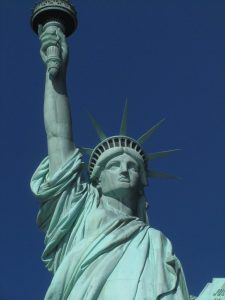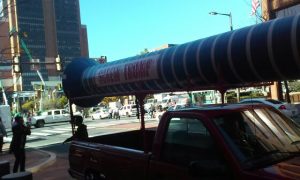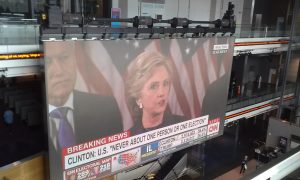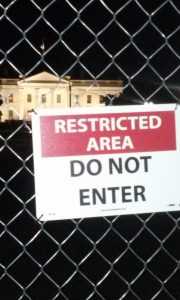On Monday, I wrote about the academic structure of the YSEALI program and the curriculum I implemented. Read Part I here. In Part II, I will continue by reflecting on the study trip itself and specific observations from each city. First up, NYC!
NYC has a strong international draw and desire to be seen by students in the program. The Statute of Liberty and Ellis Island are always a hit but interesting observations pop up throughout our time in NYC. For example, walking around the National September 11th Memorial and Museum at Ground Zero, a student and I discussed how in Indonesia, where he was from, most people he knew thought 9/11 was a myth—that it did not happen. He was surprised to see the scope of the museum and memorial, and was interested in why folks back home did not know about it or the overwhelming evidence that the event did indeed happen. In fact, a common refrain heard from international students in our programs from Southeast Asia and Africa is that the U.S. does an impressive job—according to them—of memorializing our history via museums, memorials, and saving historical buildings, especially compared to their countries where they say the preserving of history is less prioritized. Though I also discuss with them that there are many aspects to U.S. history that are not remembered, or memorialized—as history is so often rewritten, and memorialized, by the winning side.
Photo: From our trip to New York’s Liberty and Ellis Islands.
In Philadelphia, by chance we were staying a block away from where Hillary Clinton was scheduled to give her major rally with Democratic Party’s bigwigs, and musicians Bruce Springsteen and Jon Bon Jovi, on the eve of the election. We were getting a tour of Independence Hall and the Liberty Bell the morning of her rally but our bus was scheduled to take us to D.C. that afternoon (no way to have planned to stay to see that rally in advance L). Yet before we left town students got to see free speech up front and personal in the area near the rally. This led to some interesting discussions about how the kind of speech they saw would be suppressed in many of their countries—which score at the lower end of Reporters Without Borders ranking of Press Freedom. However, we also discussed how speech that overtly promoted policies that discriminated against groups, as seen at Trump rallies, was also protected political speech under our Constitution and also in human rights law. Seeing political speech in public space allowed for ideas from the classroom to take on more clear real world relevance.
Photo: Free speech alive and well—Independence Square, Philadelphia, 11/7/2016.
On Election Day we took the students to see a new addition to the Smithsonian Institute: the National Museum of African American History and Culture. This museum begins with a mile long walking exhibit that documents African-American history in chronological order from the slave trade to the election of Barack Obama. Walking with the students through this historical timeline was a unique experience that allowed them to see the fits and starts African-Americans faced in striving, and still having to do so today, for equal rights in the U.S. Many students reported that this was their favorite museum because of the experience of walking that timeline—they really liked the organization and content.
That night, informally, we took those that wanted to go watch election returns to Busboys and Poets, a restaurant, and bookstore (focused on African-American literature). The students enjoyed the festive atmosphere; with cheers for every Clinton state win projection from the mostly liberal crowd. The cheers became few and far between around 11PM when it looked like Trump might be able to pull off the Electoral College surprise victory. The place was emptying out by midnight.
On the day after Election Day, waking up to a Trump victory and a dreary rain falling over D.C., we took the students on the morgue like Metro (D.C. had the highest % voting totals for Clinton of any state/district—90.9% and lowest for Trump 4%) to the Newseum where we saw the daily headlines from Newspapers around the world (featured below) and watched Clinton’s concession speech on their big screen (featured below). Later in the day we got a tour of the U.S. Capitol building. Telling the students beforehand that the U.S. has a history of peaceful transfer of power was confirmed as the Capitol Visitor’s Center was very quiet, much shorter lines than usual, and seemingly unchanged to the naked eye from an election that will have lasting effects on the nation—although politically speaking it seems unlikely to have the effect of bringing Americans closer together as the slogan so revered on the Capitol tour, E Pluribus Unum “out of many, one” touts.
Front pages of papers from around the USA and the world at the Newseum—11/9/2016
Hillary Clinton’s concession speech on the big screen—Newseum—11/9/2016.
Overall, site visits and travel, certainly can make politics, the struggle for rights, and U.S. history from the classroom come alive. Clearly, learning takes many forms at the individual level and it is certainly hard to predict when the magic of education will strike. I look forward to checking in with these students years from now to see how their experience was shaped by being exposed to watching the functioning of the U.S. political system in real time, at sites of significance, and through discussions with Americans both in and out of the classroom. As we struggle to understand what sparks the development of critical thinking skills and memory retention, it will be interesting to see if these instances of experiential learning mixed with classroom instruction prove more salient than traditional educational approaches. My hunch is that they will and I will report on any measurable results in future blog posts. Although the college classroom does not typically allow such trips down the Eastern Seaboard—perhaps there are other approaches that could bring in more experiential approaches and informal discussions even when an educator is faced with constraints? Does anyone have examples on how to effectively include experiential learning on a smaller budget and semester constrained timeframe?
Follow us on Twitter here.
Author Jack J. Barry, Postdoctoral Fellow, Global Training and Development Institute, University of Connecticut (all photos taken by author).
Photo taken outside of White House 11-7-2016




